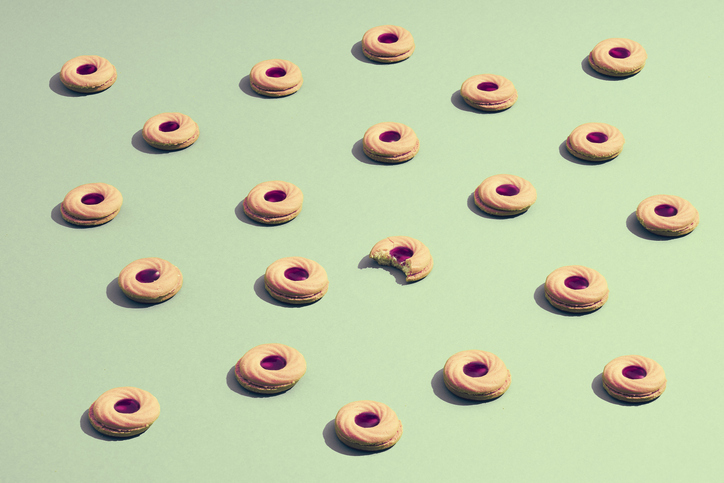I live in Los Angeles where almost every mom I know is on a diet. And not just any diet, either–a trendy diet!
Keto, paleo, Whole 30 and especially intermittent fasting (ultra trendy) are the hot topics at every play date and girls’ night out. Even when we try to talk about books and politics, we end up making pacts to cut out gluten or go vegan. Surely, we think, there’s a secret formula to weight loss, and if we keep experimenting, we’ll find it.
Of course, the problem with restrictive dieting is that it rarely works long term. The moment I lose those 5-10 pounds standing between me and my jeans, I start gaining them back again. I know I’m not the only one. I mean, look at Oprah. She can literally do anything she sets her mind to–except stay the same size. So what is the answer?
Not dieting, according to nutritionist Alyse Levine MS RD, creator of the Eating Reset program. “Every single diet out there is basically telling you that you don’t know what’s best for your body,” she said. “The diets tell you to ignore those internal cues, actually fight them, as if hunger’s a bad thing. But you’re a human being—you’re not a machine. Your actual biological needs shift from day to day. If you don’t respond accordingly, you’re going to end up feeling deprived and unsatisfied and more likely to overeat or binge.”
What is Intuitive Eating?
Instead of blindly following a one-size-fits-all diet, Levine encourages her clients to practice intuitive eating, which is, good news, an anti-diet. “The primary goal is to have a healthier relationship with food, feel physically good and never have to diet again.”
The basics of intuitive eating are listening to your body’s internal cues and not having judgment over your food choices. We’re all so programmed to think in terms of good vs. bad foods or allowed vs. forbidden foods. But Levine said to focus on “what amount and combination of foods leave you feeling good.”
A good place to start is eating mindfully. That means paying attention, enjoying what you’re eating and not multi-tasking while eating. “The irony is that most people who come to my office think they struggle with the weight because they love food so much, but the way they eat is so mindless, they’re not even tasting it,” said Levine. “So I try to really focus in on getting them to become more mindful eaters so that they first and foremost can get more satisfaction out of their food but also register when they’ve had enough.”
Levine uses the hunger/fullness scale to help her clients assess their own needs. On a scale of 1 to 10, 1 is ravenous, 10 is stuffed, and 5 is neutral. “We’re aiming to go into meals with about a 3 – a mild to moderate physical feeling of hunger – and you want to come out feeling no more than a 7,” meaning comfortably full. It takes practice to find that point of satisfaction without overeating, and journaling can help.
How to Know if You’re Really Hungry
Of course, many of us use food as a crutch. We don’t just eat when we’re hungry; but also when we’re bored, tired, anxious, socializing or just need a break. Practitioners of intuitive eating choose to eat mostly when they’re actually hungry. Kind of a radical idea, no?
If you’re not sure whether you’re truly hungry, Levine recommends taking “The Fruit Test.” When you’re craving junk food, ask yourself, would an apple satisfy me right now? If the answer is yes, then congratulations, you’re hungry. Eat the apple and see if you still need more food. If fruit doesn’t appeal to you, only potato chips, then you’re probably not actually physically hungry, so find something else to do, like take a walk, call a friend or do some deep breathing.
Another tool Levine uses is the “rule of fourths.” Whatever you’re eating, divide it into four pieces. “After each quarter, it’s a reminder to put that food down, take a deep breath and check in. Am I still enjoying what I’m eating? Am I even tasting what I’m eating right now? Am I still hungry? And if you are, by all means, go have another quarter and then go onto that same questioning before you have any more. If you have these check-ins, it helps bring the spotlight back to the meal and prevent you from missing out on all that satisfaction.”
The Importance of Self Care
Overeating happens when we’re exhausted or stressed. That’s why self care is a crucial part of intuitive eating. “If you’re not meeting your other needs, if you’re not sleeping enough, if you don’t have downtime, if you don’t have other outlets – you’re going to keep turning to food,” said Levine. “So you have to make sure your other needs are met and you have enough self care and ‘you time’ in place so food isn’t that go-to crutch.”
And if you’re looking at Alyse Levine’s gorgeous headshot and thinking “What the heck does she know about real life?”, just know that she is a mother of FOUR. Makes you want to try intuitive eating, doesn’t it?








